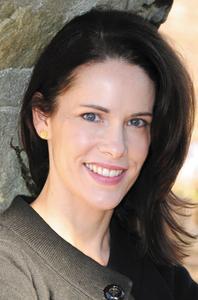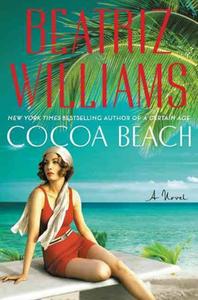
|
|
| photo: Marilyn Roos | |
A graduate of Stanford University with an MBA from Columbia, Beatriz Williams spent several years in New York and London hiding her early attempts at fiction, first on company laptops as a communications strategy consultant and then as an at-home producer of small persons, before her career as a writer took off. She lives with her husband and four children near the Connecticut shore. Her latest novel, Cocoa Beach (Morrow), is reviewed below.
One of the most intriguing elements of Cocoa Beach is its evocative setting, and your literary descriptions beautifully transport the reader into Florida's atmosphere during the 1920s. What influenced you to set this novel in that location and time?
When I visited that area of Florida during my book tour for A Hundred Summers, I was struck by the region's lush landscape and wilderness-like aspects. I was getting all these gothic vibes and knew I wanted to set a book in that environment. At the same time, I happened to be reading Only Yesterday: An Informal History of the 1920s, and I became fascinated by Frederick Lewis Allen's energetic voice, especially his chapter about Florida's social and cultural changes during that time. There were scoundrels making a quick buck, dreamers, a big land boom happening with enormous real estate development. Somehow, I had to find a way to capture all of this in a story.
All those elements seem to come together effortlessly. Were there any challenges?
Definitely. I had written historical fiction, but this was more historical psychological suspense, which was new for me. Cocoa Beach is told in a dual narrative format, a style I love because it's such a great way to juxtapose two characters and different time periods while building suspense and hooking the reader. I wrote this in a linear fashion, almost like two novels; the 1917 section was first, followed by the 1920s and then I connected the two timeframes with Simon's letters.
You have a family connection to Maitland, the plantation that is central to Cocoa Beach's plot. How did you discover this coincidence?
This is one of those things that sends shivers down my spine. My in-laws were downsizing, and while we were visiting, my mother-in-law was sorting through old papers and letters. I picked one up completely at random. In those days, letter writers included the location where they were writing from and this particular correspondence was from Maitland. "Why would one of your relatives be writing from Maitland?" I said. And my mother-in-law answered, "Because we had a plantation there." You know, just like my fictional characters did in the very next scene I was writing in Cocoa Beach, which involved my character traveling to their family's plantation in Maitland! Sadly, my family sold their plantation years ago, but this intervention of fate seems to add to the gothic flavor of the book, I think. In many ways, Cocoa Beach was a troublesome book for me to write and perhaps this was a sign that I was on the right track after all.  What interests you most about the 1920s?
What interests you most about the 1920s?
There were great historical events during that time, of course, and a focus on business. At the same time, it was a return to frivolity with people becoming interested in film stars and sporting figures. When you're talking about the '20s, it's the culture, society and people that leads to rich, character-driven stories. With few exceptions, like The Chaperone by Laura Moriarty and The Other Typist by Suzanne Rindell, there isn't much fiction set in this time. Everyone always thinks of The Great Gatsby, but Fitzgerald wrote that contemporaneously.
How do you balance the research aspect with telling a compelling story?
A considerable amount of research goes into my books, but I only bring about 10% of what I learn to each novel. I try to remember that my characters are living in their present. I don't want a history lesson to pull readers out of the scene. Instead, I weave the history into the plot, and that's a fun challenge because I need to entice the reader into figuring out and interpreting what's happening. I love when I get readers who know about the period because the more informed and engaged a reader is, the more they tend to enjoy the story while hopefully finding something new and intriguing about the characters or the plot that sparks their curiosity.
Speaking of your characters, several people from your book A Certain Age reappear in Cocoa Beach.
I think I've been slowly building up to this book over the course of several others. One character in Along the Infinite Sea was beginning a new life and I gave her a villa in Cocoa Beach. There's a line about buying it "after the 20s, when it was built in the land boom." I knew that somehow, a few books later, that same villa was going to be the focus of a different novel. While I was writing A Certain Age, I gave my main character Sophie a sister named Virginia, who had an absent husband. All this family really knew about this husband was that Virginia met him while she was a nurse in World War I, there were these letters and she had to go to Florida after he died.
It's a fun connection without being required reading. You don't have to read A Certain Age before Cocoa Beach.
Exactly right. When I heard someone refer to the comics and superhero world as a "shared universe," I thought, "That's what I do, too!" Theoretically, you can read any one of my books alone but having that knowledge about the backstory enriches the story a little more.
So, do you envision any of your characters from Cocoa Beach making a reappearance in another novel?
Yes. There's some mystery to the ending of Cocoa Beach, as readers will discover. It's intentional and related to The Wicked City, which was published in January 2017. I wrote Cocoa Beach before The Wicked City, which takes place two years after Cocoa Beach. My next book is The Wicked Redhead and readers should look forward to seeing a familiar character or two. --Melissa Firman, writer, editor and blogger at melissafirman.com

